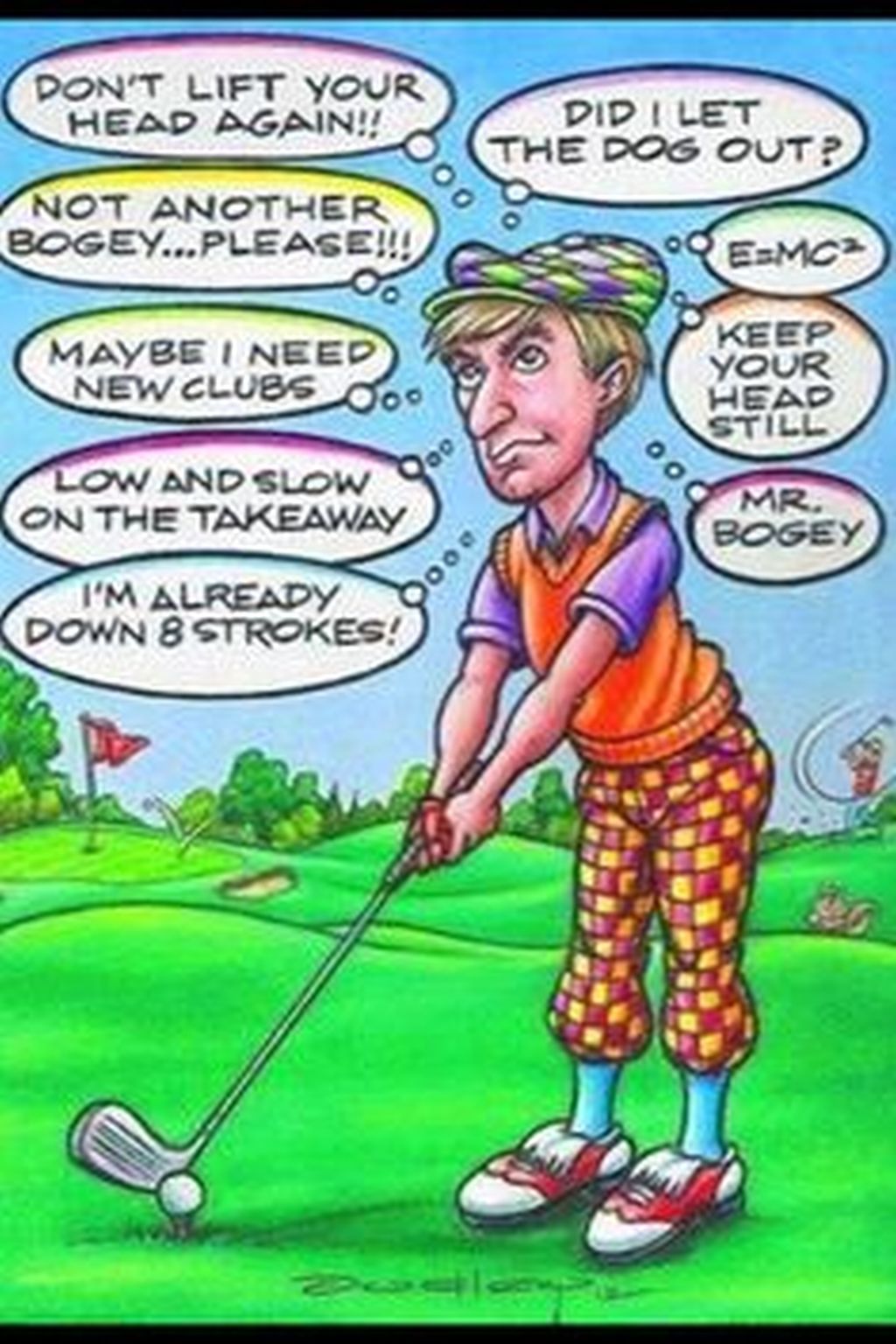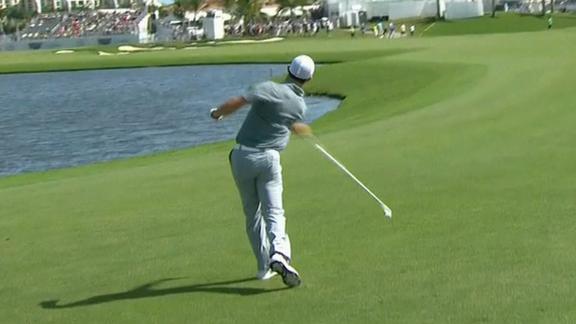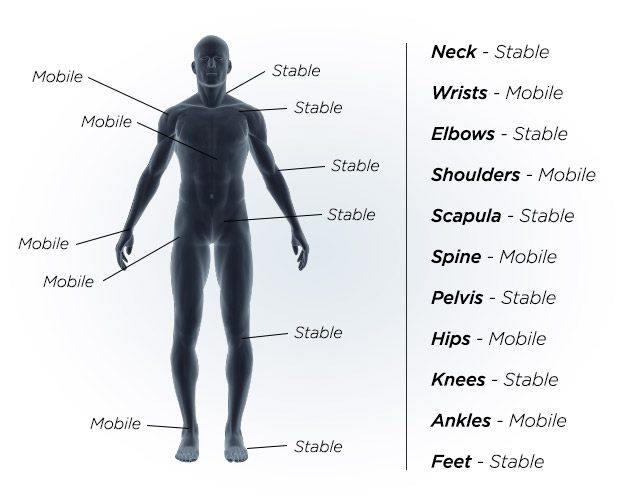Golf Swing Thoughts Help Develop Consistency
Swing thoughts on the practice range are an unquestioned strategy. They simplify a complex situation. They speed the learning process. And they help develop trust in your swing. How about during a match? Do swing thoughts help there? What are the best swing thoughts to have?
While instructors differ on which are the best swing thoughts during a match, they all agree on one thing: Thoughts like “Keep your elbow tucked in,” Finish with your belt buckle facing the target,” or “Keep your head still” only foul up your swing when playing. In fact, many golf tips on swing thoughts reject the whole idea.
It’s not that these thoughts are bad. They’re not. They’re right on target. Entire golf lessons are designed around them. And they’re great in practice. They keep you focused on what you’re doing.
But eliminate them during a match. Why? They focus on swing mechanics and that’s something to avoid when actually swinging a club. Golf is a game of feel.
Check any golf instruction manual. They will tell you the same thing: You can’t command your body to work in a certain way when hitting the ball. Trying to do so creates more problems than it solves. All the mechanics of your swing should be in place before you hit the course.

Instead, focus on your target. That, after all, is your real goal. Forget about where your hands are or where your hips are.
Concentrate on where you want the ball to land and link to it creatively and emotionally. Develop a mental picture of that spot and keep it in mind as you swing.
If you must have a swing thought, keep it simple. And non-mechanical. Many PGA pros focus on a single thought, which eliminates thoughts about swing mechanics, and ideally taps into the feel of your golf swing.

Personally, my swing thought is “skipping stones”. I’ve skipped stones ever since I was a kid. And skipping stones encapsulates a vast portion of the mechanics that are used in a golf swing- full hip and shoulder turn in the backswing.... maximum trail arm depth...
..starting weight transfer/hip rotation to target before I reach the top of my back swing, and pulling my trail elbow toward my pocket and groin (and more).
All to generate club head speed and keep my swing plane and path, and to get my club face square at impact. That one thought embraces all that I’ve been working on at the range and allows me just to feel my swing.
Ernie Ells keeps this thought in mind when he swings “Low and slow.” That’s it. He doesn’t think about where his hands are, where his weight is, or where his body is going to end up. That’s for when he’s taking a golf lesson from his swing coach. Instead, he focuses on taking the club back low and slow, eliminating everything else.
Fred Shoemaker, author, a pioneer in golf instruction, and founder of the golf school Extraordinary Golf, is adamant about swing thoughts. Replace thoughts about your mechanics with thoughts about the “feel” of your swing. Think about tempo and rhythm rather than where and when. If you must have a swing thought, says Fred, have one that reinforces the feel of your swing.
Fred has his students practice throwing clubs to emphasize this idea. At first, they throw a club 15 feet. Then, they throw one with a slightly fuller swing, about 25 feet or so. After about 200 throws, they throw one with a complete golf swing. Of course, this club throwing is done under strict supervision and safety conditions.

Once Fred’s students master club throwing, they move to the tee. The goal there is remembering how it feels to throw a club when you hit a ball. They focus on that idea and that idea alone.
The best Approach
The best approach is to have a thought that triggers something, or a chain of somethings, in your swing (e.g. skipping stones for me), thoughts that
- Mentally in-plant your target line
- Mimics the actual swing
- Produces a smooth take away
- Triggers the downswing.
- Promotes relaxation while swinging
Establish a target line for your ball flight before you address the ball. Keep that thought in mind when you hit and try to copy it with your ball flight. That forces you to keep the target line in mind, not your mechanics.
Most professional golfers take a few practice swings before they address the ball. They want the feel of the swing before they hit the ball. Recreational golfers ought to do the same. Take a few practice swings. Remember how it feels. Keep that “feel” in mind when you hit.
N.B. many amateur golfers have issues with proprioception (knowing where your body is in three-dimensional space) and kinaesthesia (The perception of body position and movement/The ability to feel movements of the limbs and body). This makes it real hard to feel your swing. But there are many quick and simple things you can do to regain this and help your swing mightily.
Focus on a thought that promotes a smooth takeaway. Slow and easy. Or, slow and smooth. Anything that produces a nice takeaway helps. Remember, the takeaway and backswing do one thing: position you for the downswing.

The downswing begins the chain reaction of feet, knees, thighs, hips and shoulders. Any thought that triggers this chain reaction helps deliver the blow at impact.
Try thoughts like, “Plant your left heel,” or “Slide your left knee toward the target.” Anything that helps you transfers your weight to your left side works well.
Also try to complete the backswing in a relaxed manner. Think of anything that will occupy the time between your takeaway and the completion of your backswing. That brief time is critical. It’s when golfers think about their mechanics instead of their targets.
Consistency is every golfer’s goal. To achieve it, we need a swing that is repeatable under pressure every time we play. Developing that swing, however, isn’t easy. It takes hard work and plenty of practice.
It is also important to link your swing thought – if you use one – to your pre shot routine. Again, you do that at the range doing drill after drill. It’s not for the course.
When you get to the course you ideally want that environment to trigger automatic responses that you have practiced and rehearsed over and over again, so that you don’t have to overthink things, keep it simple, and just feel your swing.
Having a simple one thought process that repeats itself time and time again helps you develop that swing as well. If the mental side of your game syncs with the physical side, achieving swing consistency gets easier.
More importantly, it cuts strokes from your game, which, in turn, generates a lower handicap.


Keep functioning ,terrific job! https://www.timaseczki.pl maseczka wielorazowa
Great article! That is the type of information that should be shared across the web. Claudina Hermy Bysshe
Nice of you to take the time to send such lengthy and heartfelt replies Lianda! Fidelity Baily Clarette
I agree with your opinion. From now on I will always support you. Andi Tobie Fidelity
Apologies for the delay in replying, its been a bit covid crazy here. Thanks
You can increase your speed by making sure you stay parallel as you do squats. Neala Ivan Gagnon
Thanks for your personal marvelous posting! I definitely enjoyed reading it, you happen to be a great author. I will make sure to bookmark your blog and will eventually come back later in life. I want to encourage continue your great job, have a nice morning! Walliw Bryanty Katleen
I really like and appreciate your blog post. Want more.
Im thankful for the blog.Much thanks again. Want more.